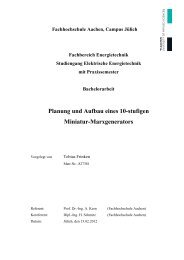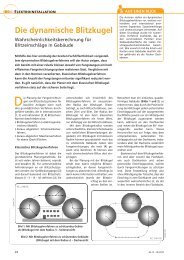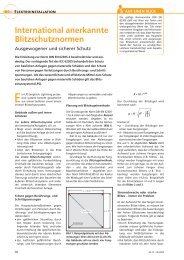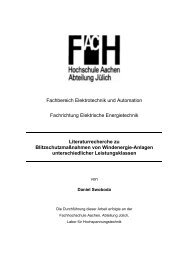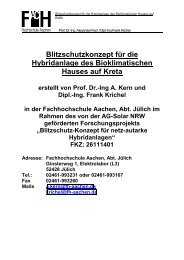Simulation of electric and magnetic fields using FEMM - FH Aachen ...
Simulation of electric and magnetic fields using FEMM - FH Aachen ...
Simulation of electric and magnetic fields using FEMM - FH Aachen ...
Create successful ePaper yourself
Turn your PDF publications into a flip-book with our unique Google optimized e-Paper software.
2. Electrical Field<br />
Before we deal with some current flow problems, we should first underst<strong>and</strong>--<br />
What is an <strong>electric</strong>al field?<br />
In physics, an <strong>electric</strong> field surrounds <strong>electric</strong>ally charged particles <strong>and</strong> time-varying<br />
<strong>magnetic</strong> <strong>fields</strong>. This <strong>electric</strong> field exerts a force on other <strong>electric</strong>ally charged objects.<br />
Michael Faraday introduced the concept <strong>of</strong> an <strong>electric</strong> field.<br />
The <strong>electric</strong> field is a vector field with SI units <strong>of</strong> newtons per coulomb (N/ C) or,<br />
equivalently, volts per meter (V/m). The strength or magnitude <strong>of</strong> the field at a given point is<br />
defined as the force that would be exerted on a positive test charge <strong>of</strong> 1 coulomb placed at<br />
that point; the direction <strong>of</strong> the field is given by the direction <strong>of</strong> that force. Electric <strong>fields</strong><br />
contain <strong>electric</strong>al energy with energy density proportional to the square <strong>of</strong> the field<br />
amplitude. The <strong>electric</strong> field is to charge (E=F/q) as gravitational acceleration is to mass<br />
(a=g*m/r 2 ) <strong>and</strong> force density is to volume (f= dF/dV).<br />
An <strong>electric</strong> field that changes with time, such as due to the motion <strong>of</strong> charged particles in the<br />
field, influences the local <strong>magnetic</strong> field. That is, the <strong>electric</strong> <strong>and</strong> <strong>magnetic</strong> <strong>fields</strong> are not<br />
completely separate phenomena; what one observer perceives as an <strong>electric</strong> field, another<br />
observer in a different frame <strong>of</strong> reference perceives as a mixture <strong>of</strong> <strong>electric</strong> <strong>and</strong> <strong>magnetic</strong><br />
<strong>fields</strong>. For this reason, one speaks <strong>of</strong> "electromagnetism" or "electro<strong>magnetic</strong> <strong>fields</strong>". In<br />
quantum mechanics, disturbances in the electro<strong>magnetic</strong> <strong>fields</strong> are called photons, <strong>and</strong> the<br />
energy <strong>of</strong> photons is quantized. 10<br />
2.1 Cable 1<br />
Assume we have a perfect concentric cable. At inner cable a voltage <strong>of</strong> 130kV (compare to<br />
the ground) is applied.<br />
Layer 1 Layer 2<br />
σr (S/m) 3 2<br />
Table 2-1 Value <strong>of</strong> the <strong>electric</strong>al conductivity<br />
We will draw the field pr<strong>of</strong>ile E=f(r) <strong>of</strong> this cable as well as a plot <strong>of</strong> E=f(r).<br />
2.1.1 Create a new file.<br />
“File”→“New”→ “Current Flow Problem”<br />
2.1.2 Set problem definition.<br />
Press Menu: “Problem”. Change problem type to “Axisymmetric” <strong>and</strong> Unit length to<br />
“millimeters”.<br />
10 Electric field in "Electricity <strong>and</strong> Magnetism", R Nave




